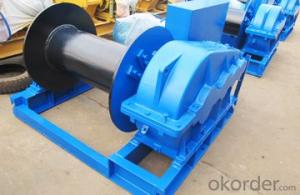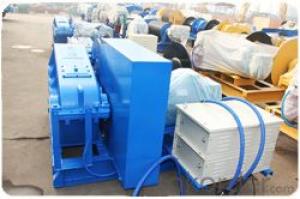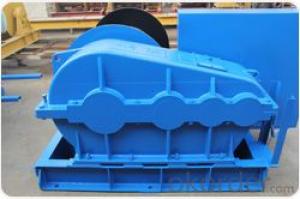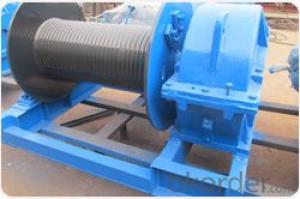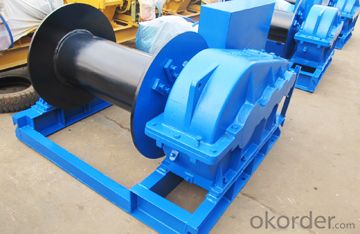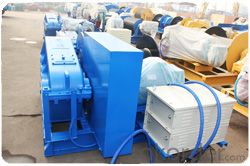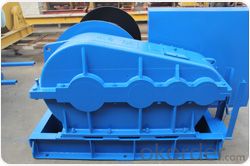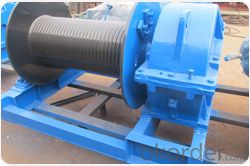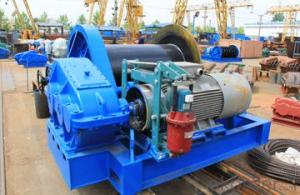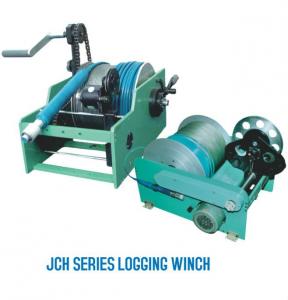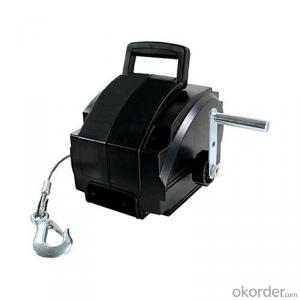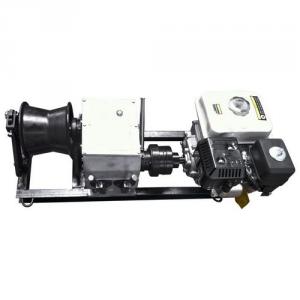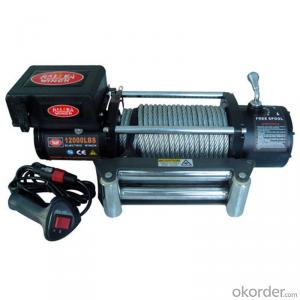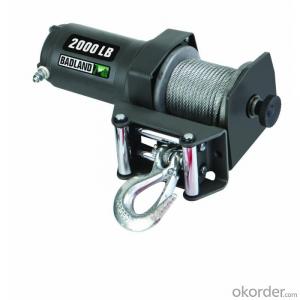Low Speed Electric Winch
- Loading Port:
- Shanghai
- Payment Terms:
- TT OR LC
- Min Order Qty:
- 1 unit
- Supply Capability:
- 30 unit/month
OKorder Service Pledge
OKorder Financial Service
You Might Also Like
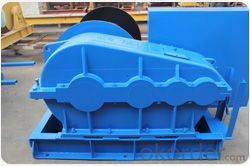
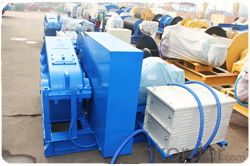
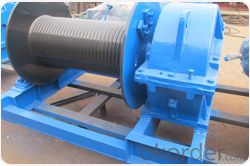
This series is slow speed electric motor driven gear winch; It is mainly used for hoisting, drag-and-drop, loading cargos, such as all kinds of large concrete construction, steel constructions installation and disassembly; The winches are applied to construction company, mine, factory and other installation engineering projects company;
Technical Data:
Basic Parameters | Rated Load | Average Speed | Capacity of Rope | Rope Diameter | Motor Power | Overall Dimension | Total Weight |
Model | KN | m/min | m |
| KW | mm | kg |
JM1 | 10 | 15 | 100 | 9.3 | 3 | 620×701×417 | 270 |
JM1.6 | 16 | 16 | 150 | 12.5 | 5.5 | 945×996×570 | 500 |
JM2 | 20 | 16 | 150 | 13 | 7.5 | 945×996×570 | 550 |
JM3.2 | 32 | 9.5 | 150 | 15.5 | 7.5 | 1430×1160×910 | 1100 |
JM3.2B | 32 | 12 | 195 | 15.5 | 7.5 | 1082×1014×610 | 536 |
JM5 | 50 | 10 | 270 | 21.5 | 11 | 1235×1230×805 | 1560 |
JM5B | 50 | 9.5 | 200 | 21.5 | 11 | 1620×1260×945 | 1800 |
JM5C | 50 | 9.5 | 350 | 21.5 | 11 | 1235×1230×805 | 1800 |
JM5D | 50 | 15 | 350 | 21.5 | 15 | 1235×1230×805 | 1850 |
JM5E | 50 | 20 | 350 | 21.5 | 22 | 1235×1230×805 | 2000 |
JM6 | 60 | 9.5 | 270 | 24 | 15 | 1235×1509×805 | 1800 |
JM8 | 80 | 8 | 250 | 26 | 15 | 2090×1475×956 | 2900 |
JM8B | 80 | 9.5 | 350 | 26 | 15 | 1075×1598×985 | 2650 |
JM10 | 100 | 8 | 170 | 30 | 22 | 2090*1475*956 | 3000 |
JM10B | 100 | 9.5 | 250 | 21.5 | 22 | 1705*1598*985 | 3500 |
JM12.5 | 125 | 8 | 300 | 34 | 30 | 2880*2200*1550 | 5000 |
JM13.5 | 135 | 8 | 290 | 28 | 22 | 2990*2362*1650 | 6500 |
JM16 | 160 | 10 | 500 | 37 | 37 | 3750*2400*1850 | 8800 |
JM20 | 200 | 10 | 600 | 43 | 45 | 3950*2560*1950 | 9900 |
JM25 | 250 | 9 | 700 | 48 | 55 | 4350*2800*2030 | 13500 |
JM32 | 320 | 9 | 700 | 56 | 75 | 4500*2850*2100 | 14800 |
JM50 | 500 | 9 | 800 | 65 | 90 | 4930*3050*2250 | 19500 |
JM65 | 650 | 10.5 | 3600 | 64 | 160 | 5900*4680*3200 | 46000 |
- Q: What are the requirements for the construction elevator
- Actually good or bad for safety device can only judge by test and inspection in the daily operation is not sure whether it is good or bad, for those who are serving for safety device, or advice for the earlier inspection and regular test, only accomplish know fairly well, to malignant accident prevention rather than cure.
- Q: Is it possible to utilize building hoists in environments with high altitudes?
- <p>Yes, building hoists can be used in high-altitude environments, but their performance may be affected. At high altitudes, reduced air density can lead to decreased efficiency in hoist operations, particularly those powered by combustion engines. It's crucial to select hoists designed for high-altitude use, which may include features such as high-altitude ignition systems and special lubricants. Additionally, regular maintenance and adjustments to the hoist's operation parameters are necessary to ensure safety and optimal performance.</p>
- Q: This question asks for the steps or methods to change the height at which a building hoist operates.
- <p>To adjust the height of a building hoist, follow these steps: Ensure the hoist is powered off and unplugged. Locate the height adjustment mechanism, which is typically a set of bolts or a telescoping system. Loosen any locking nuts or bolts to allow movement. Adjust the hoist height by raising or lowering the platform to the desired level. Once the correct height is reached, tighten the nuts or bolts to secure the hoist in place. Test the hoist to ensure it operates safely at the new height. Always refer to the manufacturer's instructions for specific details on your hoist model.</p>
- Q: The construction elevator always jumps
- The starting current is more than three times the running current, and your air switch is low in the maximum current
- Q: Is there a specification requirement for the floor door of the elevator to the floor? How high
- The door locks must be in the direction of the elevator, and the people on the floor are not allowed to move at will, only the driver will be able to move. The other is that the height of the door must be 1.8 meters high, so that the workers' heads don't reach out to the danger.
- Q: This question asks about the various elements that can influence the efficiency and effectiveness of a building hoist.
- <p>The performance of a building hoist is affected by several factors including the type and weight of materials being lifted, the frequency of use, the hoist's mechanical condition and maintenance, environmental conditions such as wind and temperature, the skill and training of operators, and the design and capacity of the hoist itself. Proper installation, regular inspections, and adherence to safety protocols also play a crucial role in ensuring optimal performance and safety. Additionally, the quality of electrical systems, the efficiency of the drive mechanism, and the structural integrity of the hoist's components can significantly impact its operation.</p>
- Q: Is it possible to use a lifting device to lift objects that are heavier than its specified maximum load?
- <p>No, a lifting device should never be used to lift objects that exceed its rated load capacity. Doing so can lead to catastrophic failure of the device, potentially causing serious injury or death. Always adhere to the manufacturer's specifications to ensure safety and prevent accidents. Overloading a lifting device can result in structural damage, compromised safety mechanisms, and increased risk of collapse or dropping the load. It is crucial to respect the load limits to maintain the integrity and reliability of the lifting equipment.</p>
- Q: Describe the process of utilizing a computer control system for operating a building hoist.
- <p>To use a computer control system for a building hoist, first ensure the system is properly installed and integrated with the hoist's mechanical and electrical components. Begin by powering on the control system and checking for any error messages that might indicate a problem. Once the system is ready, input the desired parameters such as load weight, lifting height, and speed settings. Use the control panel to initiate the hoist's movement, monitoring the progress on the system's display. Adjust the hoist's operation in real-time as needed, ensuring safety protocols are followed. Regularly check system diagnostics for maintenance alerts and address any issues promptly to maintain optimal performance.</p>
- Q: The tower crane is on a surface with the construction elevator, and only 2 or 3 meters away. Is that allowed
- There are no rules for the distance between tower crane and construction elevator, but note the following points: (1) the foundation of the tower crane and the construction elevator cannot affect each other; (2) the construction elevator shall not be higher than the tower crane. (3) the location of the elevator shall not be blocked by the position of the construction elevator; (4) the use of the same circuit and the same distribution box with the construction elevator shall not be used by the tower crane. The distance between the tower crane and the construction elevator can be anywhere, as long as the above aspects are met.
- Q: What is the meaning of double straps in the construction elevator?
- One component of the elevator's drag system is the weight of the car. The other side of the car is connected to the top of the car by dragging a wire rope. It can be used for the energy saving of the elevator towing system, because the elevator load optimization is calculated by the theory calculation. The elevator should be calculated before the weight is weighed: the calculation principle is that the weight is equal to the weight of the car and half the load.
Send your message to us
Low Speed Electric Winch
- Loading Port:
- Shanghai
- Payment Terms:
- TT OR LC
- Min Order Qty:
- 1 unit
- Supply Capability:
- 30 unit/month
OKorder Service Pledge
OKorder Financial Service
Similar products
Hot products
Hot Searches
Related keywords
